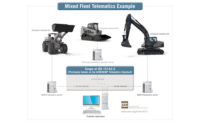
The Association of Equipment Management Professionals (AEMP) unveiled a comprehensive telematics standard March 1 during its annual management conference in Las Vegas. AEMP began pursuing a telematics standard in 2008 with input from manufacturers Caterpillar, Volvo, Case, Komatsu and John Deere.
The new standard, set for release in October, consists of 19 data elements and 42 default codes. It creates a universal data set addressing seven main areas: utilization, excessive idle, location, job availability, inspection, electronic usage proof, and preventative maintenance.
“A lot of thought was put into this,” said Daniel Samford, vice president of corporate equipment, Herzog Contracting Corp., St. Louis, Mo. “We don't need to know everything, just the certain things that benefit us."
The standard coordinates, streamlines and prioritizes telematics data into a cohesive set of useful information accessible through a single portal rather than a piecemeal approach sorting through statistics from various equipment manufacturers drawn from multiple sources. It enables a holistic fleet approach as opposed to collating individual machine performance. The end result is a time and cost savings realized through preventative maintenance, improved productivity, fuel efficiency and theft prevention, among other areas. Effective data management from machine sensors can affect up to 70% of a fleet's operating costs.
Telematics can add value in expected ways, too, adding transparency with project owners while providing specifications for transportation. It can also reduce insurance premiums.
“Our insurance provider waived six deductibles because we had telematics on it,” Samford said. “At $10,000 per machine, it created a $60,000 savings. We no longer have to factor theft into our bid costs with telematics.”
Telematics may also help boost used equipment values, which are traditionally based on hours of operation. Fleet owners can now segregate machine use from idle time for clearer picture of equipment wear-and-tear. It can additionally aid in project claims and change orders by clearly identifying machine location and usage for customer billing.
“As the standard becomes more accepted by the providers, there is going to be opportunity for standardization of that data that drive economies of scale for better pricing,” said Gregory Puckett, director of machine-to-machine solutions, Oldcastle Materials Inc., Atlanta. “Most rental companies are still evolving their telematics program.”
AEMP will update the standard every two years, addressing new issues and technology as necessary. A crane telematics standard could be forthcoming in the next round of updates, hinted AEMP executive director Stan Orr. (Link-Belt is reportedly developing a crane telematics standard based on roughly 254 data points).
A larger challenge still lies in integrating telematics data into management practices. Few companies currently incorporate equipment information into operational practices unless they are large enough to develop an internal management program, says one industry expert in attendance. Packaged data for clear return-on-investment can justify software expenditures linking telematics with company practices such as connecting equipment usage with internal billing rates.
“Data is good but if you don't know how to manage and present it, it’s useless,” Puckett said. “A lot of folks have had false starts with telematics.”
In the meantime, AEMP is pressing for manufacturer compliance with the new standard and encouraging its membership to do the same.
“Telematics is the future,” Orr said. “And it’s going to save your company money.”


Post a comment to this article
Report Abusive Comment